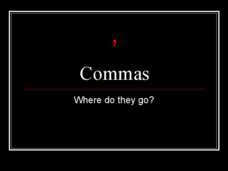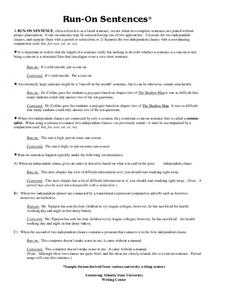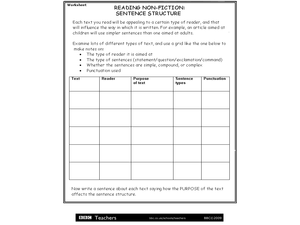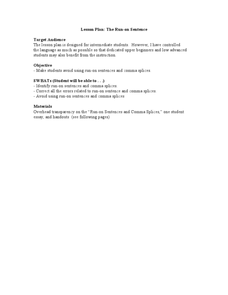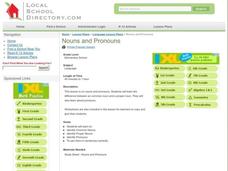Curated OER
Renewable Energy Sentences
Students construct sentences using nouns and verbs from a "renewable energy" word bank. In this cross curriculum ecology and sentence structure grammar and mechanics instructional activity, students listen to the book Our Earth: Clean...
Curated OER
Simple, Compound, and Complex Sentences
Discuss simple, compound, and complex sentences using this resource. Using a series of examples, learners talk about the characteristics of these types of sentences. This is a quick and easy way to cover this topic.
Curated OER
Sentence Structure: Hellen Keller Biography
Readers identify sentence structure -- simple, compound, complex, compound-complex -- in 10 examples based on Helen Keller's life story.
San José State University
Sentence Fragments
Work on sentence fragments with your class using this handout and brief exercise. This resource, which could be used as a reference sheet for learners, goes into detail about complete sentences and the different errors that cause...
Curated OER
Eliminating Wordiness
Teach your class how to write concisely and edit writing. The slide show covers be verbs, active voice, passive voice, repetitive wording, and more. Complete with numerous examples and images, it is a comprehensive resource that could be...
Curated OER
Transition Words
Do your emergent writers need extra practice using transitions? After reading a brief definition, learners select a transition from the provided word bank that best completes the sentences in each set. No answer key is provided.
Curated OER
Friendly Letter Writing and Sentence Structure
Explore communication through writing by analyzing individual sentences with young writers. They practice writing compound sentences and identifying sentence fragments. The next step has them learn the five parts of a friendly letter....
Curated OER
Common and Proper Nouns
Identify nouns in speech and writing. Learners find all the nouns in a read-aloud story. Then, they complete a worksheet that reviews the use of nouns, verbs, adjectives, prepositions, conjunctions, pronouns, and interjections. A list of...
Curated OER
Commas: Where Do They Go?
Help your class use commas properly using this resource. Learners discuss the use of commas in a list, before a conjunction, and as part of a qualifying statement. At the end of the presentation there is a quiz.
Curated OER
English Skills: Vocabulary and Spelling Practice
Learners complete various activities using their spelling words, which are not provided on the worksheet. Activities include using spelling words alliteratively, finding synonyms, using words in sentences with specified parts of speech,...
Curated OER
Testing... Testing...
Students demonstrate critical- and creative-thinking skills to develop test questions. They write clear test questions or statements using correct grammar, spelling, and sentence structure.
San José State University
Writing Concisely: Deleting or Replacing Unnecessary Information
Are you actually feeling really tired of reading wordy, redundant, long, lengthy sentences practically all the time over and over again? Introduce writers to this handout and exercise to teach to tighten up their prose! Provides two ways...
San José State University
Avoiding Nominalization
Improve syntax with this explanatory handout. It clarifies one way to make writing more precise: avoiding nominalization. This resource provides four ways to find and change nominalization problems and 10 sentences to correct. There are...
Curated OER
Run-On Sentences
Have you seen run-on sentences in your learners' writing lately? If you're looking to address this issue, you might use this run-on sentence handout as a reference sheet. This handout lists examples of run-on sentences as well as...
Curated OER
Dashes and Hyphens
Review the use of dashes and hyphens. This presentation comes with a series of examples to make the concept understandable. While a useful resource, it could be augmented with a greater number of examples.
Curated OER
The Sentence Contest
Students review the definition of a sentence and identify the sentences (complete thoughts) from a list of possibilities. Students evaluate complete and incomplete sentences by being judges at a sentence contest.
Curated OER
Reading Non-Fiction: Sentence Structure
Use this worksheet to help make explicit the connection between sentence structure, audience, and author's purpose. Readers track and find patterns in sentence structure in various nonfiction texts, and connect it to the purpose of the...
Curated OER
Writing Review 3
After reviewing basic capitalization and punctuation rules, give your young grammarians this four-question quiz to assess their understanding of the most basic English language conventions.
Curated OER
The Run-On Sentence
Explore grammar rules by completing a worksheet. In this sentence structure lesson, kids define run-on sentences and read sample sentences to determine whether they are complete or incomplete. There is also a space for the writer to edit...
Curated OER
Sea to Sky Adjectives Booklet
Adjectives build better sentences! First, second, third, and fourth graders design adjective booklets that feature words to describe everything between the sea and the sky.
Curated OER
Grammar Casino
Young scholars correct, explain, and recognize grammatical mistakes. They complete worksheets, and play a Grammar Casino game. Students check sentences for correctness and discuss what is right or wrong about each sentence. Young...
Curated OER
Jabberwocky-Identifying Adjectives
Elementary learners identify adjectives in sentences. They read the poem "Jabberwocky" by Lewis Carroll and highlight the adjectives. A good supplemental lesson if you are studying Lewis Carroll and/or "Jabberwocky."
Curated OER
Gender Neutral Language
Tackling gender issues in your class? This online quiz about gender neutral language might be for you! Learners re-write 10 sentences using gender neutral language. When they have finished re-writing each sentence, they can check their...
Curated OER
Nouns and Pronouns
Young readers explore nouns and pronouns. They define what a noun is and highlight the nouns in given sentences. Learners are then introduced to pronouns, and identify them in simple sentences.










